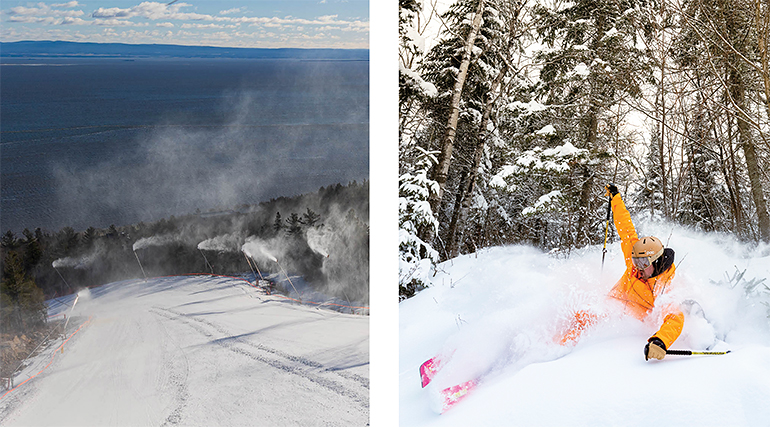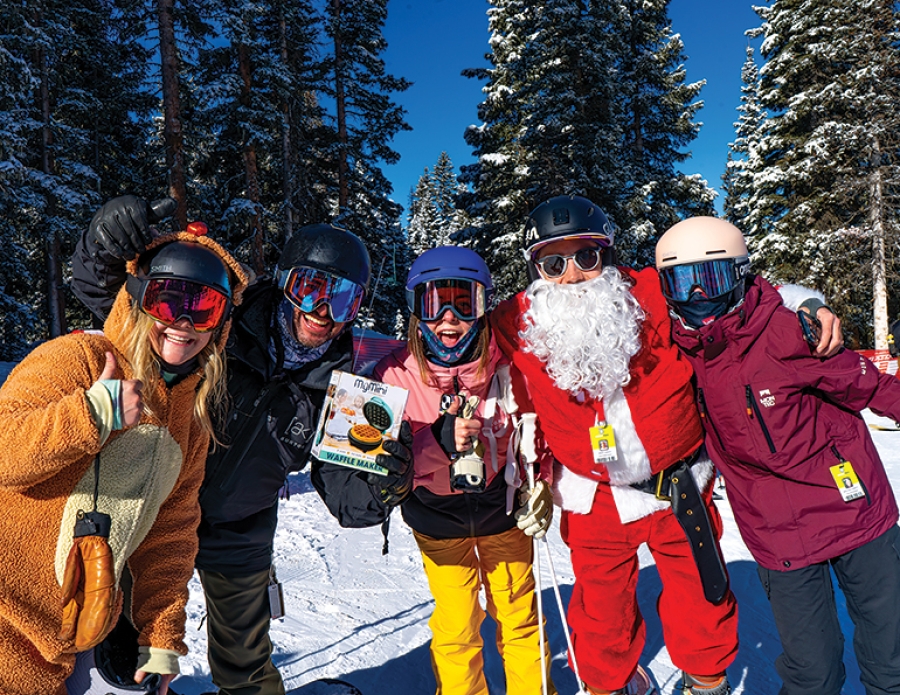December and the all-important Christmas holiday period were a bust for many North American resorts this year. Mild temps, lean snow, and rainy weather made for an unusually slow start to the 2023-24 ski season across the country. Some resorts were not even able to open, and others offered only limited terrain. Nationally, only about 12 percent of the country had any snow cover at all for Chrismas—the lowest percentage ever.
Resorts got a boost when powerful storms rolled across the country in the first half of January, followed by cold Arctic temps. The resulting snow and snowmaking weather ushered in a happier new year for many. On Jan. 10, Le Massif de Charlevoix, Quebec, invited skiers to the mountain for “Christmas, Take 2” to celebrate 18 inches of long-awaited snow, topped off with a drawing for a new pair of skis or snowboard.
 Left and right: Le Massif de Charlevoix in Quebec depended heavily on snowmaking resources until an early January storm delivered 18 inches of fresh snow. Guests were invited to “Christmas, Take 2” to celebrate.
Left and right: Le Massif de Charlevoix in Quebec depended heavily on snowmaking resources until an early January storm delivered 18 inches of fresh snow. Guests were invited to “Christmas, Take 2” to celebrate.
But were early January snowstorms enough to boost the bottom line? If not, what measures were operators planning to get their budgets and visits back on track? And, given its unpredictable weather, is Christmas week still a good benchmark for business?
FEELING THE IMPACTS
It was a “tough holiday,” said Christian Knapp, chief marketing officer at Pacific Group Resorts, Inc., owner/operator of six North American resorts from the East Coast to Vancouver Island. Several of PGRI’s properties felt the impact of a slow start, including Mount Washington, B.C. “The Pacific Northwest has been very challenged, with minimal natural snow and warm temperatures,” said Knapp.
Ready for recovery. He expected business to recover in the PNW once snow started flying. “We’re being very transparent there about conditions,” said Knapp. “Once conditions normalize, the market will respond. We’re the only area on [Vancouver] Island. People look to us as their conduit.”
Knapp said PGRI’s large investment in snowmaking at Wisp, Md., should also pay off. “The unique thing about resorts in the Mid-Atlantic, if temperatures cooperate, they can optimize snowmaking and open up a big percentage of their terrain very fast compared to out west or New England,” he said.
Lean is good. New England was indeed hard hit, soaked with back-to-back heavy rain storms the two weekends before Christmas. Rough holiday conditions aren’t necessarily a death knell for smaller drive-tos, though. “Christmas is not make or break for us,” said Mount Southington, Conn., GM Jay Dougherty. “We’re a day area. Our best years are lean snow years when people stay local.”
Despite the weather, the ski area managed to open Dec. 23 with six runs. “As a coastal resort, we’re used to coastal weather and have a robust snowmaking system,” said Dougherty.
Wary guests. The Midwest was also plagued with unusually warm December temperatures. Granite Peak, Wis., was closed Christmas Eve and Day thanks to record-breaking high temps, so the ski area was down during the post-holiday period, said GM Greg Fisher, as were its sister resorts, Snowriver, Mich., and Lutsen Mountains, Minn.
To increase visitation, said Fisher, the resort was advertising discount promotions that have historically relied on word-of-mouth. The goal is to pull in “those that may be wary of the conditions due to the winter we are seeing,” said Fisher.
“In a season like this, where I know we are not the only ones down, it’s hard to simply rely on doing any sort of drastic discounting or alternative programming, in my opinion,” said Fisher. Instead, Granite Peak also planned to message more heavily around its snowmaking capabilities to assuage concerns about conditions.
At Red Lodge, Mont., marketing and sales director Troy Hawks said Christmas business levels were down about 30 percent. “Our regional drive-to and out-of-state visits were down to a small extent, while visits from our season pass holders (who enjoy our acres of off-piste, more advanced terrain) were down to a larger extent,” said Hawks.
Sharing is caring. Several Montana ski areas, such as Blacktail and Maverick, were unable to open in December and early January due to lack of snow. To help keep Montanans on-snow and local hills in business, Showdown, Discovery, Bridger Bowl, and other neighbor resorts stepped in to offer free lift tickets to passholders from the closed resorts.
As Showdown GM Katie Boedecker explained, small ski areas operating with tight margins cannot afford to refund passes or lose future sales when the weather turns bad, as either hit can seriously impact cash flow.
BELT TIGHTENING?
Resorts responded to the poor holiday and start to the season in a variety of ways, from cutting expenses to offering special promos and leaning more heavily into their core operating strategies.
At Mount Southington, Dougherty said he was “pulling back on staff, but not to the point guests would notice. Staff were brought on later than usual, but spent the first couple of weeks training anyway.”
“We’re not running as many lifts,” he added, noting that following Christmas week, the mountain quickly turns its attention to revenue-generating activities like racing and school programs.
At Granite Peak, said Fisher, “during the holiday period we were aggressive with staffing, meaning that we were trying to be lean while providing our [normal] guest service standards. We were able to do this primarily in food and beverage, tickets, and to a lesser degree, in lifts (as we didn’t have all our lifts spinning as in seasons past).”
Killington, Vt., also looked to shave costs in F&B, cutting back on duplicated food and beverage outlets midweek. “We will continue to be full service and fully staffed on the weekends,” said brand marketing and communications manager Kristel Killary.
At Red Lodge, Hawks said department managers kept a keen eye on business, “so we were able to keep our expense on wages down, on par with business levels. We are now targeting our advertising toward boosting spring business in late February to early April, months we normally see our largest natural snowfall.”
Pacific Group Resorts’ Knapp echoed those sentiments, saying, “We’re always cognizant of expenses and carefully managing business. Weather variances in December, unfortunately, are not unusual. We’re used to weather variances; it’s baked into the business at this point.”
Offer good value. Knapp said the company was pleased with a two-night, ski free, month-long promo it offered from late December to early January at Wintergreen, Va. “We were very, very aggressive” with the promo, said Knapp, which allowed people to book their stay for anytime during the season. “We saw incredible pick-up and bookings spread across January, February, and March. Due mostly to the offer, we’re now pacing ahead on lodging occupancy for the remainder of the winter season. It far exceeded our expectations,” he added. “We’re looking at variations at other properties.”
At the Mountain Capital Partners family of resorts, all of which were down in visits after the Christmas holiday period, marketing director Stacey Glaser said the company has doubled down on its mission to provide good value to skiers and riders.“Rather than belt tightening,” she said, “we’re offering as much terrain and lifts as quickly as we can, even in a slow snow year. We’re leaning more heavily than ever into our strategy of pricing, selling tickets at good value in good and low snow years, and giving people the freedom to ski. It’s a strategy we know has worked.”
STILL AN IMPORTANT BENCHMARK?
With Christmas week becoming less of a sure thing, is it still the vital benchmark for a successful season it’s always been, or does that thinking need to change?
Still key. “Nothing has changed in my years of working at different resorts,” Glaser said. “There are peaks and valleys. This year’s valley landed toward the beginning of the season. We know that’s not always the case. Christmas and holiday weeks are very important, and it’s important to keep that mindset.”
Knapp agreed that Christmas week remains an important benchmark. “No matter how you cut it, Christmas week is a big part of your overall revenue picture,” he said. “If you completely miss it, it’s very hard to recover.”
“This year was more challenging than we’d like,” he continued. “Some of our properties, like Jay Peak (Vt.) and Wintergreen, have a lot to offer beyond skiing. Guests still come. They might not ski as many days, but they enjoy all the other amenities, being with their families. Christmas remains a very important market.”
But he said the industry needs to think about pricing the holiday differently. “Typically, we price it at a high premium. Sometimes, conditions don’t merit that price. I think the industry needs to look itself in the eye and think what is a fair price to charge when conditions are not always perfect.”
A time for learn-to. Hawks agreed that “Christmas/New Year is still an important period for us, as this is when most families have time off from work and school to make a ski trip. But, we were focusing more on beginner to intermediate skiers and riders during this time. [It was] a great time to learn how to ski or snowboard, with mild temperatures, and great groomed beginner terrain available.”
Along those lines, he said he’d like to see the resurrection of a national learn to ski and snowboard campaign to help attract more beginners to the sport. “It’s difficult for small- to medium-sized ski areas to have the resources needed to reach those who might consider taking up the sport of skiing and snowboarding,” he said, noting that Learn to Ski & Snowboard Month, while not perfect, was a useful platform.
Long view. Many said season-long business was more important than a single holiday week. “We’re a day area,” said Dougherty. “It’s more important for us to be open consistently through the season.”
Fisher agreed: “The ski season is often benchmarked by the big three holidays—Christmas, MLK, and Presidents’ Weekend. But if you focus more on the entire season you can make up ground due to some pent-up demand.”
The first holiday period is still helpful for dialing in operations, Fisher noted. “We used Christmas Week as a guidance to what we felt was an adequate staffing level,” he said. “It was pretty much the first time we were busy enough with all buildings and outlets operating to really gauge some of our estimates on staff we’d need.”
The impacts of the season’s rough beginnings have yet to fully play out. Season pass presales likely insulated many from an irrecoverable hit to the bottom line. But it’s not clear yet how restricted early season operations might affect spring pass sales. Will folks feel as though their pass had limited use, or will their memories be short as long as the season turns around?
There’s reason to be optimistic. “As we know, in this business, snowfall is king,” said Jordan Elliott, president of the Pacific Northwest Ski Areas Association. And a slow start might be overcome or at least offset by a strong finish. “Demand is, of course, pent up,” said Elliot, “and after the massive storm that hit the entire Northwest (in January), with more to come, things are starting to look pretty good.”






